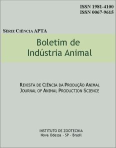Variations δ 1 3 C values in faeces, milk and blood of lactating cows in grass-legume pastures
Abstract
The trial was carried out at the Estação Experimental Central of the Instituto de Zootecnia, in Nova Odessa. State of São Paulo, Brazil. The ratio of natural 12C and 13C isotopes n the feed, faeces, milk and blood of lactating cows were determined in the Centro de Energia Nuclear na Agricultura - Piracicaba, State of São Paulo. Using this technics it was. evaluated the proportion of C-3 species (tropical legumes) and C-4 species (tropical grasses) selected by lactating cows grazing grass-legume pastures and the correlation of the δ 1 3 C values determined in the faeces, milk and blood. The work was carried out in two steps: step - lactating cow were penned and fed com silage alone or perennial soybean hay substituting for corn silage; step II - the lactating cows were mantained in different pasture treatments as follows: A) green panic with nitrogen fertilization; B) green panic mixed with perennial soybean; C) setaria cv. Kazunyula with nitrogen fertilization; D) setaria cv. Kazungula mixed with perennial soybean. The results showed that: 1) The δ 1 3 C values in the faeces and in the milk of the penned lactating cows decreased quickly in the first three days after changing com silage by perennial soybean hay, while €˜,ad less variation in the blood; 21 The δ 1 3 C values in the faeces, milk and blood of lactating cows grazing grass-legume pastures were more negative than those of the cows grazing grass alone, demonstrating to have an effective intake of perennial soybean by the cows grazing the mixed pasture; 3) There was more intake of perennial soybean by the cows during April (autmn) than January (summer). This was showed by the results of the δ 1 3 C values in the faeces; 4) The correlation coefficients were highly significative (P < 0.01) between faeces and milk = 0.90, blood and milk 0.61, and significative (P < 0.05) between faeces and blood = 0.48; 5) The crude protein contents either of the forage available or the diet selected by esophageal fistulated steers were higher in the grass-legume pastures than in the single grass pastures.Downloads
Downloads
Published
Issue
Section
License
Os autores não serão remunerados pela publicação de trabalhos, pois devem abrir mão de seus direitos autorais em favor deste periódico. Por outro lado, os autores ficam autorizados a publicar seus artigos, simultaneamente, em repositórios da instituição de sua origem, desde que citada a fonte da publicação original seja Boletim de Indústria Animal. A revista se reserva o direito de efetuar, nos originais, alterações de ordem normativa, ortográfica e gramatical, com vistas a manter o padrão culto da língua e a credibilidade do veículo. Respeitará, no entanto, o estilo de escrever dos autores. Alterações, correções ou sugestões de ordem conceitual serão encaminhadas aos autores, quando necessário. Nesses casos, os artigos, depois de adequados, deverão ser submetidos a nova apreciação. As opiniões emitidas pelos autores dos artigos são de sua exclusiva responsabilidade. Todo o conteúdo deste periódico, exceto onde está identificado, está licenciado sob a Licença Creative Commons Attribution (CC-BY-NC). A condição BY implica que os licenciados podem copiar, distribuir, exibir e executar a obra e fazer trabalhos derivados com base em que só se dão o autor ou licenciante os créditos na forma especificada por estes. A cláusula NC significa que os licenciados podem copiar, distribuir, exibir e executar a obra e fazer trabalhos derivados com base apenas para fins não comerciais.













